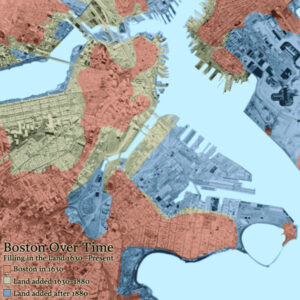For much of its early history, Boston was a city expanding into the sea.
A hilly peninsula prior to colonization, the city began the labor-intensive process of removing its hilltops to fill in the surrounding coves, marshes and mud flats at the end of the 18th century.
The summit of Beacon Hill, adjacent to the Massachusetts State House, was carted off in the early 1800s, while Mount Vernon and Pemberton Hill, which formed the peninsula’s “Trimountain” landmark alongside Beacon Hill, fared even worse. In the words of Boston historian Walter Muir Whitehill, “the hills have all but disappeared.”
Today, more than half the city is built on a landfill foundation of former hilltops and assorted city waste. As a result, a major portion of Boston’s streets, bars, apartments and power infrastructure are located just above historical flood lines.
The outward expansion has enabled Boston to become the city it is today but also has made it especially vulnerable to the rising tides that threaten to force the city into retreat.
By 2100, the sea level around Boston is projected to rise by two to five feet, according to a 2022 report by the University of Massachusetts Boston.
The report projected precipitation intensity to increase by 20 to 30%, while sea level rise likely will push up groundwater levels and increase groundwater salinity along the coast. If emissions continue at current rates, 100-year flooding events could become annual occurrences by the end of the century.
“Risk-averse end users of these projections should consider the possibility of sea level outcomes above the likely range, especially under higher GHG emissions,” the UMass report noted. “For long-term planning and long-lived coastal assets, we stress that sea level will continue rising beyond 2100 under all GHG emissions scenarios.”
Rising Costs of Resiliency, Recovery
In Boston and throughout the broader region, climate-fueled extreme weather events already are stressing essential energy infrastructure.
“We see a lot of concern about the ability of the grid to withstand even current — not to mention future — storms, sea level rise and other climate impacts,” said John Walkey, director of climate justice and waterfront initiatives at the environmental justice nonprofit GreenRoots.
As climate change accelerates, “all our past planning and forecasts go out the window,” Walkey said.
Massachusetts’ electric utilities have incurred major costs associated with storm recovery in recent years. Eversource, one of the state’s two major electric distribution companies, is seeking to recover about $339 million in costs associated with three storms that occurred between 2021 and 2022, including $176 million from a single 2021 Nor’easter (D.P.U. 22-143).
Over the past decade, Eversource’s contributions to its storm fund, which is intended to stabilize the impacts of storm costs on ratepayers, have increased from about $5 million to $31 million annually (D.P.U. 22-22).
In the fall of 2021, Eversource reported its storm fund had a $122 million deficit, which the company attributed in part to increasingly frequent storms “due to weather patterns and meteorological characteristics associated with climate change.”
In a recent interview, Massachusetts Department of Public Utilities Chair Jamie Van Nostrand emphasized it’s the utilities’ responsibility to prepare their systems for increasing pressures from climate change.
With more frequent and severe extreme weather events and increasing property values, elevated storm costs are “not necessarily a matter of the utilities being imprudent,” Van Nostrand told RTO Insider. “But we’ll also be looking closely at, ‘Could that have been avoided? Could you have designed your system in a way that would have been more resilient?’”
In 2022, Massachusetts passed a bill requiring the state’s electric utilities to file electric-sector modernization plans (ESMPs) with the DPU every five years. The bill requires the utilities to detail how they plan to upgrade their systems to facilitate the clean energy transition and mitigate climate damage. (See Mass. Utilities Submit Grid Modernization Drafts.)
The utilities filed their final plans in January, which the DPU should rule on in late August, Van Nostrand said.
“Even without that specific statutory directive, I think that part of our job is to put the utilities on notice that we’re watching, and we want you to take [climate resilience] into account,” Van Nostrand said, adding that utilities will “run the risk of a prudence disallowance” if they incur costs that could have reasonably been avoided by proactive climate mitigation.”
The utilities’ ESMPs outline major investments to meet increasing peak loads and enable the transition to more distributed generation. Eversource estimates it will need to build 17 new substations and upgrade 26 substations by 2035.
“It’s very timely that we’re looking at the climate change resilience piece,” Van Nostrand said, “because we’re going to be installing a lot of substations, upgrading a lot of substations, and we want to make sure the utilities are mindful as they’re making all these investments.”
While storm costs are often driven by downed trees and branches, large flooding events can pose a significant threat to substations.
National Grid, Massachusetts’ other major electric utility, noted in its ESMP filing that flooding in its Rhode Island service territory in 2010 forced the company to remove eight substations from service and caused “significant customer outages and loss of high-value substation equipment.”
The company wrote that it used Federal Emergency Management Agency (FEMA) flood maps to analyze its substation fleet in the aftermath of the events to identify vulnerabilities.
“Flood mitigation efforts have been implemented at approximately 40 substation locations with approximately 20 additional projects planned,” National Grid wrote.
Elli Ntakou, Eversource’s manager of system reliability and resiliency planning, said the utility assesses risk based on FEMA flood data and sea level rise projections from the City of Boston and the National Oceanic and Atmospheric Administration.
“Especially for sea level rise, we want to be comprehensive,” Ntakou said.
Elevation in East Boston
Sea level rise resiliency has been one point of contention in the lengthy fight over Eversource’s proposed substation on the banks of Chelsea Creek in East Boston, which has led to demonstrations and arrests of protesters attempting to stop construction.
Environmental justice organizations and residents have argued Eversource failed to conduct adequate community engagement on the project and have expressed concern that future climate-driven flooding could inundate the substation, endangering the surrounding neighborhood.
GreenRoots and the Conservation Law foundation have a pending legal challenge before the Massachusetts Supreme Judicial Court regarding the Energy Facilities Siting Board’s (EFSB’s) approval of the project (EFSB 14-04A).
“We don’t feel as if they really prepared for the lifespan of this facility, [or] they prepared for the lifespan of a transformer,” said Walkey of GreenRoots, adding that substations can last for more than a century.
Eversource considered sea level rise over a 40-year equipment lifespan and selected a design flood elevation — “the lowest elevation at which the Substation equipment should sit on the site” — of four feet above the 500-year flood line.
Eversource said the substation “was approved following a comprehensive, yearslong public review process” and that the company “comprehensively demonstrated that the project is designed to mitigate flood risks well beyond any flood study for the project.”
The EFSB ruled Eversource “appropriately addressed risks associated with sea level rise” and added that “building the substation at a higher elevation would likely add costs to project development and provide unclear benefits.”
Future Uncertainty
One major challenge of planning for coastal flooding is the high level of uncertainty associated with projecting future emissions, as well as how largescale earth systems will react to different warming scenarios.
While Boston is likely to experience sea level rise of two to five feet, “that’s really all we can say, because it depends on the emissions of greenhouse gases,” said Paul Kirshen, professor of climate adaptation at UMass Boston and a lead author of the UMass climate impacts report.
“If we can get to net zero by 2050, it could only be two feet. If we keep on the rate we’re going, it could be five feet,” Kirshen said.
He added there is an “outside chance” that sea level rise could reach up to 10 feet by the end of the decade, depending on the degree of melting on ice sheets in Greenland and Antarctica.
“It’s a low probability,” Kirshen said, “but that would obviously be a real game changer.”
Climate change also could increase the potential for low-probability, high-consequence compound flooding events in which river flooding coincides with a storm surge, Kirshen said.
“We’re at the confluence of three rivers — the Mystic, the Charles and the Neponset River — and there’s always the possibility of those rivers being flooded from precipitation at the time that we get a major coastal storm,” Kirshen said. “Not only would you get flooding from the ocean from the storm surge, but you’d also get the Charles River and the Mystic River overflowing their banks.”
To help account for the changing climate risk profiles, in recent years the DPU has mandated that newly sited projects reassess their climate vulnerability every five years and take any additional necessary mitigation measures.
“It just makes sense if you’re installing energy infrastructure that’s going to have a lifespan of 30, 40, 50 years,” said DPU Chair Van Nostrand. “We’re always getting more information, and if anything, I think the information we’ve gotten is a little bit scarier. … Sea level rise might be even worse than we were thinking.”
Some environmental organizations and legislators are looking to require even more comprehensive climate resilience planning from the utilities. One bill reported favorably out of the legislature’s Telecommunications, Utilities and Energy Committee would require the state’s investor-owned utilities to submit a climate vulnerability assessment and adaptation plan every five years.
Johanna Epke, staff attorney at the Conservation Law Foundation, said current requirements have provided limited visibility into how the utilities are planning for climate impacts.
“They’re not required to file any of their modeling or any of their assessments,” Epke said. “We want that out in the public space, we want to be able to scrutinize that, and we want to have experts in the advocacy community comment on that.”
Van Nostrand said he thinks the DPU already has the statutory authority to require climate vulnerability assessments as part of the ESMP process.
“As a result of the 2022 climate law, we will be making specific findings on climate vulnerability assessments when we issue the August order on this first round of ESMPs,” Van Nostrand said. “Apart from that, we can also rely on our broad regulatory oversight powers to be able to say, ‘We think that it’s part of utility practice that you perform this kind of a study and manage your system in a way that manages risks.’”





